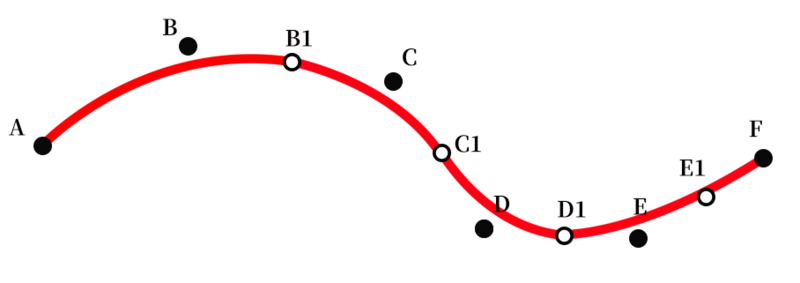转自:https://www.jb51.net/html5/641000.html
背景概要
相信大家平时在学习canvas 或 项目开发中使用canvas的时候应该都遇到过这样的需求:实现一个可以书写的画板小工具。
嗯,相信这对canvas使用较熟的童鞋来说仅仅只是几十行代码就可以搞掂的事情,以下demo就是一个再也简单不过的例子了:
|
1
2
3
4
5
6
7
8
9
10
11
12
13
14
15
16
17
18
19
20
21
22
23
24
25
26
27
28
29
30
31
32
33
34
35
36
37
38
39
40
41
42
43
44
45
46
47
48
49
50
51
52
53
54
55
56
57
58
59
60
61
62
63
64
65
66
67
68
|
<!DOCTYPE html><html><head> <title>Sketchpad demo</title> <style type="text/css"> canvas { border: 1px blue solid; } </style></head><body> <canvas id="canvas" width="800" height="500"></canvas> <script type="text/javascript"> let isDown = false; let beginPoint = null; const canvas = document.querySelector('#canvas'); const ctx = canvas.getContext('2d'); // 设置线条颜色 ctx.strokeStyle = 'red'; ctx.lineWidth = 1; ctx.lineJoin = 'round'; ctx.lineCap = 'round'; canvas.addEventListener('mousedown', down, false); canvas.addEventListener('mousemove', move, false); canvas.addEventListener('mouseup', up, false); canvas.addEventListener('mouseout', up, false); function down(evt) { isDown = true; beginPoint = getPos(evt); } function move(evt) { if (!isDown) return; const endPoint = getPos(evt); drawLine(beginPoint, endPoint); beginPoint = endPoint; } function up(evt) { if (!isDown) return; const endPoint = getPos(evt); drawLine(beginPoint, endPoint); beginPoint = null; isDown = false; } function getPos(evt) { return { x: evt.clientX, y: evt.clientY } } function drawLine(beginPoint, endPoint) { ctx.beginPath(); ctx.moveTo(beginPoint.x, beginPoint.y); ctx.lineTo(endPoint.x, endPoint.y); ctx.stroke(); ctx.closePath(); } </script></body></html> |
它的实现逻辑也很简单:
- 我们在canvas画布上主要监听了三个事件:
mousedown、mouseup和mousemove,同时我们也创建了一个isDown变量; - 当用户按下鼠标(
mousedown,即起笔)时将isDown置为true,而放下鼠标(mouseup)的时候将它置为false,这样做的好处就是可以判断用户当前是否处于绘画状态; - 通过
mousemove事件不断采集鼠标经过的坐标点,当且仅当isDown为true(即处于书写状态)时将当前的点通过canvas的lineTo方法与前面的点进行连接、绘制;
通过以上几个步骤我们就可以实现基本的画板功能了,然而事情并没那么简单,仔细的童鞋也许会发现一个很严重的问题——通过这种方式画出来的线条存在锯齿,不够平滑,而且你画得越快,折线感越强。表现如下图所示:
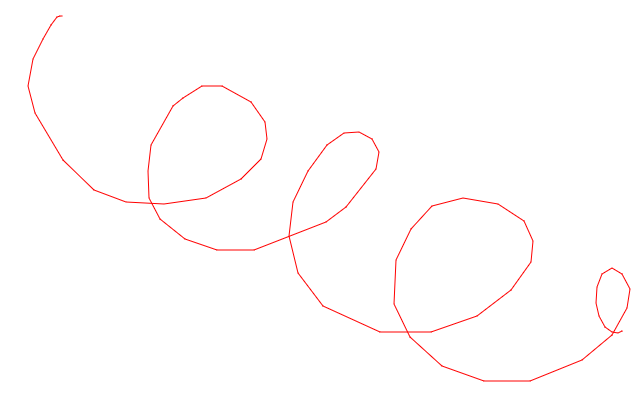
为什么会这样呢?
问题分析
出现该现象的原因主要是:
我们是以canvas的lineTo方法连接点的,连接相邻两点的是条直线,非曲线,因此通过这种方式绘制出来的是条折线;
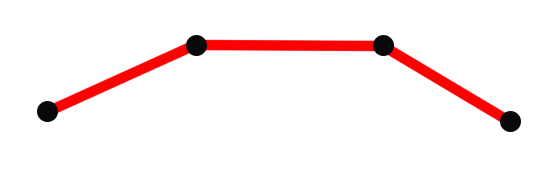
受限于浏览器对mousemove事件的采集频率,大家都知道在mousemove时,浏览器是每隔一小段时间去采集当前鼠标的坐标的,因此鼠标移动的越快,采集的两个临近点的距离就越远,故“折线感越明显“;
如何才能画出平滑的曲线?
要画出平滑的曲线,其实也是有方法的,lineTo靠不住那我们可以采用canvas的另一个绘图API——quadraticCurveTo ,它用于绘制二次贝塞尔曲线。
二次贝塞尔曲线
quadraticCurveTo(cp1x, cp1y, x, y)
调用quadraticCurveTo方法需要四个参数,cp1x、cp1y描述的是控制点,而x、y则是曲线的终点:
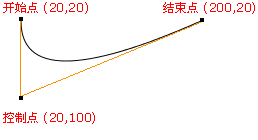
更多详细的信息可移步MDN
既然要使用贝塞尔曲线,很显然我们的数据是不够用的,要完整描述一个二次贝塞尔曲线,我们需要:起始点、控制点和终点,这些数据怎么来呢?
有一个很巧妙的算法可以帮助我们获取这些信息
获取二次贝塞尔关键点的算法
这个算法并不难理解,这里我直接举例子吧:
假设我们在一次绘画中共采集到6个鼠标坐标,分别是A, B, C, D, E, F;取前面的A, B, C三点,计算出B和C的中点B1,以A为起点,B为控制点,B1为终点,利用quadraticCurveTo绘制一条二次贝塞尔曲线线段;
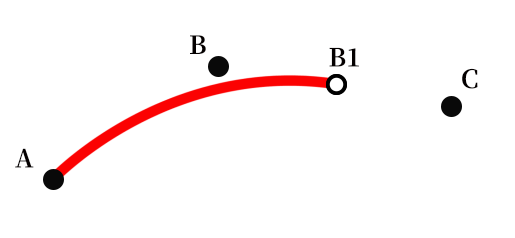
接下来,计算得出C与D点的中点C1,以B1为起点、C为控制点、C1为终点继续绘制曲线;
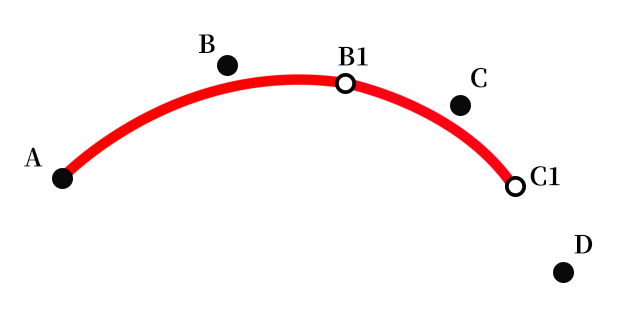
依次类推不断绘制下去,当到最后一个点F时,则以D和E的中点D1为起点,以E为控制点,F为终点结束贝塞尔曲线。
OK,算法就是这样,那我们基于该算法再对现有代码进行一次升级改造:
|
1
2
3
4
5
6
7
8
9
10
11
12
13
14
15
16
17
18
19
20
21
22
23
24
25
26
27
28
29
30
31
32
33
34
35
36
37
38
39
40
41
42
43
44
45
46
47
48
49
50
51
52
53
54
55
56
57
58
59
60
61
62
63
64
65
66
67
68
69
70
71
72
|
let isDown = false;let points = [];let beginPoint = null;const canvas = document.querySelector('#canvas');const ctx = canvas.getContext('2d');// 设置线条颜色ctx.strokeStyle = 'red';ctx.lineWidth = 1;ctx.lineJoin = 'round';ctx.lineCap = 'round';canvas.addEventListener('mousedown', down, false);canvas.addEventListener('mousemove', move, false);canvas.addEventListener('mouseup', up, false);canvas.addEventListener('mouseout', up, false);function down(evt) { isDown = true; const { x, y } = getPos(evt); points.push({x, y}); beginPoint = {x, y};}function move(evt) { if (!isDown) return; const { x, y } = getPos(evt); points.push({x, y}); if (points.length > 3) { const lastTwoPoints = points.slice(-2); const controlPoint = lastTwoPoints[0]; const endPoint = { x: (lastTwoPoints[0].x + lastTwoPoints[1].x) / 2, y: (lastTwoPoints[0].y + lastTwoPoints[1].y) / 2, } drawLine(beginPoint, controlPoint, endPoint); beginPoint = endPoint; }}function up(evt) { if (!isDown) return; const { x, y } = getPos(evt); points.push({x, y}); if (points.length > 3) { const lastTwoPoints = points.slice(-2); const controlPoint = lastTwoPoints[0]; const endPoint = lastTwoPoints[1]; drawLine(beginPoint, controlPoint, endPoint); } beginPoint = null; isDown = false; points = [];}function getPos(evt) { return { x: evt.clientX, y: evt.clientY }}function drawLine(beginPoint, controlPoint, endPoint) { ctx.beginPath(); ctx.moveTo(beginPoint.x, beginPoint.y); ctx.quadraticCurveTo(controlPoint.x, controlPoint.y, endPoint.x, endPoint.y); ctx.stroke(); ctx.closePath();} |
在原有的基础上,我们创建了一个变量points用于保存之前mousemove事件中鼠标经过的点,根据该算法可知要绘制二次贝塞尔曲线起码需要3个点以上,因此我们只有在points中的点数大于3时才开始绘制。接下来的处理就跟该算法一毛一样了,这里不再赘述。
代码更新后我们的曲线也变得平滑了许多,如下图所示:
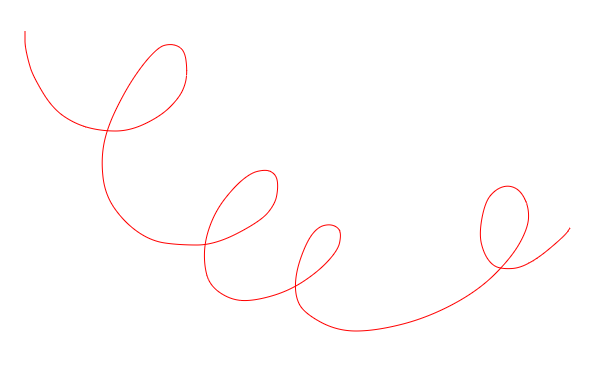
本文到这里就结束了,希望大家在canvas画板中“画”得愉快~我们下次再见:)
